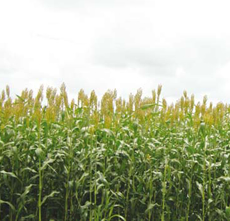For Bumper Harvest, we Must get it Right on Seeds
While breeders have the scientific knowledge and methods, farmers are good at identifying traits that suit their particular environments and resource levels.
 With a rapidly growing population, food demands are increasing pressure on the fixed and dwindling land resource, not to mention the rising degradation of the environment coupled with uncertainties resulting from climate change.
With a rapidly growing population, food demands are increasing pressure on the fixed and dwindling land resource, not to mention the rising degradation of the environment coupled with uncertainties resulting from climate change.
To complicate the matter further, low yields are rampant across the African continent, Kenya included.
According to the Association for Strengthening Agricultural Research in Eastern and Central Africa (ASARECA) 2011 report, the average yields of maize in East Africa is 1.5 tonnes per hectare (t/ha) compared to global average of 4.5 t/ha. This is closely linked to unavailability of planting materials.
To increase production, the solution lies in seed enhancement or improvement technology through plant breeding to generate the best quality seeds that are more productive and are pest and disease-resistant. As opposed to natural selection where only the strongest seeds survive, germplasm is a deliberate scientific process of improving seed quality and using this for production. It ensures that seeds of lower quality are removed from circulation.
Germplasm production is fundamental to modern agriculture. Crops and livestock are established from seeds with seed quality having major impact on potential yields. Production should understand farmers’ needs in terms of the crops they prefer as well as the varieties they like and should be welladapted to the various environments as well as resistant to prevalent diseases and in affordable prices and proper packaging.
Seed enhancement technologies include coating by application of materials on the seed surface that contains protectants such as fungicides and film coating, which reduces loss of active material from seeds during transport and handling.
Then there is pelleting, which delivers a range of beneficial additives including micronutrients and plant protection and is also used to alter seed shape, surface properties, density and size to enable more precise seed singulation and placement in the planting tray and soil and priming, which is used to increase germination rate and uniformity and overcome seed dormancy. The following recommendations are useful in guiding seed multiplication:
Research:
There is need to develop robust crops adapted to wide range of agro-ecologies. Varieties developed should allow farmers to conserve natural resources.
Conservation:
Seed systems should integrate conservation of farmers’ varieties on smallholder farms. This will help in sustaining evolutionary systems that are responsible for the generation of genetic variability.
Investments in seed production:
There is need for investments towards increasing availability of improved seeds by producing foundation seed, investing in storage facilities and production of sufficient quantities of quality seeds that meet the market demands.
Private sector participation:
There is need to create an enabling environment for private sector participation in seed trade through versatile policy environments. The private sector has the initial capital and capacity to make a difference in seed availability over a long time.
Rationalisation of seed trade policy:
Harmonisation of seed policies, laws and regulations is important in facilitating flow of seeds across national boundaries. This increases choice of quality seed for farmers leading to increased productivity.
Seed policy:
There is need for integrated holistic agricultural policies that would promote and implement global diversity of seed cultivars, support the development and spread of agricultural systems based on a holistic approach, where human, crop, animal, microbial biodiversity are an indispensable tool for increasing productivity, efficiency, and resilience of farming systems. Payment of royalties to plant breeders is important as motivation and incentive.
Seed Trade Associations:
There is need to strengthen associations since their role in the sector is critical. They are responsible for protection of genuine seed procedures and farmers through strict enforcement of national seed laws, lobby and advocacy and promotion of regional formal seed trade.
Rethink traditional local varieties:
There is need for more research on improved varieties of traditional food staples.
Coordination between breeders and farmers:
While breeders have the scientific knowledge and methods, farmers are good at identifying traits that suit their particular environments and resource levels.
Dr Mutunga is CEO Kenya National Farmers Federation (KENAFF)